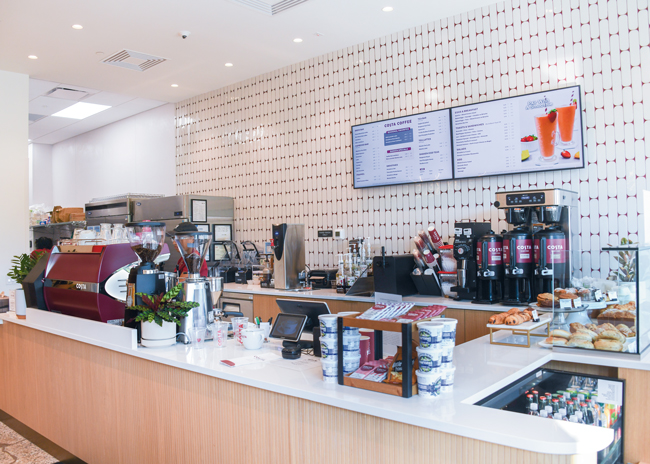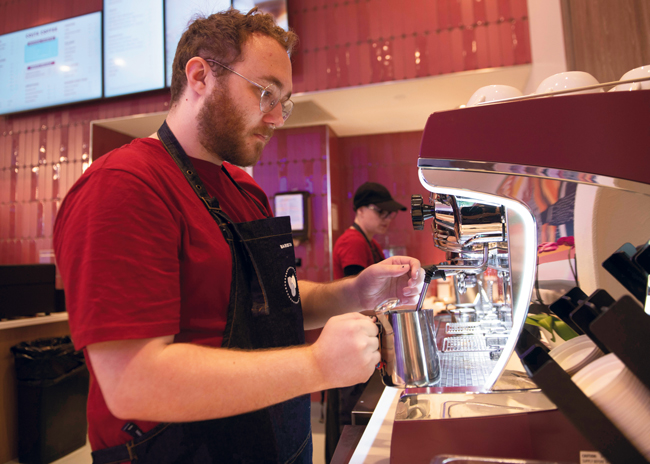This dominant British coffee chain pursues U.S. expansion plans with a twist
The Brits are coming. And they’re bringing coffee.
In 2022, Costa Coffee entered this country from its native U.K. It has opened six coffee shops in the U.S. and is developing its brand presence, but it’s approaching this market very differently.
And it has to, really. In the U.S. the coffee market is dominated by Starbucks, which reportedly has more than 17,000 locations stateside and would be a formidable competitor to go up against. Conversely, in the U.K., Costa has more than 2,700 stores to Starbucks’ 1,300 or so.
Costa is not planning to open any more retail stores in the U.S. Its goal, instead, is twofold: First, to become the go-to coffee provider for offices, hotels, and other operators. And secondly, to offer its products through its own vending machines, in places where there’s not enough space for a full coffee shop, especially if there’s a lot of after-hours business. Erica Brown, Costa’s vice president and managing director, Americas, says the idea is to create multiple ways for consumers to thoroughly engage with the brand.
Costa Coffee started small. In 1971 Italian brothers Sergio and Bruno Costa began crafting their signature coffee on Fenchurch Street in London. That signature coffee bean blend became known as Mocha Italia, which is still served today and is a blend of arabica and robusta coffees. They opened their first coffee shop in 1981 and then started expanding, beginning with London’s most prestigious neighborhoods.
Costa continued as an independent operator until 1995, when the chain was acquired by Whitbread, a large hotel and coffee shop operator in the U.K. Coca-Cola then acquired the brand in 2019 for $4.9 billion. Coca-Cola has since jumped feet-first into coffee. In 2023 it hired Philippe Schaillee as the global CEO of Costa Coffee. Schaillee’s background includes stints with Krups, Sara Lee (in a coffee-related role) and Jacobs Douwe Egberts. Within a decade, Costa Coffee’s goal is to reach $1 billion in sales in the U.S., and to become the number one business-to-business coffee company.
Five of Costa Coffee’s stores reside in Atlanta, Coca-Cola’s headquarters. The sixth store sits inside the Seattle-Tacoma International Airport. The Atlanta locations provide exposure for a brand that Brown concedes is virtually unknown in the U.S. These units are also great test locations, she says, which help the brand better understand American consumer behavior. Seattle works well as an airport location, Brown points out, because it’s a frequent layover spot for travelers between the U.S., and China, where Costa has a strong presence.
 Images courtesy of Costa Coffee
Images courtesy of Costa Coffee
At a Glance
- Chain headquarters: Atlanta
- Year founded: 1971
- Founders: Sergio and Bruno Costa
- CEO: Philippe Schaillee
- Senior director of strategic sales: David Ferreira
- Signature menu items: cafe latte, flat white, espresso, cappuccino, cortado, iced whipped lattes
- Number of units: 4,100 worldwide; six in the U.S.
- Average unit size: 2,000 square feet
- FOH: 1,600 square feet
- BOH: 400 square feet
 Costa’s Smart Cafés will play a big role in Costa’s U.S. expansion.
Costa’s Smart Cafés will play a big role in Costa’s U.S. expansion.
Costa-Branded Automated Vending
Smart Cafés, which are essentially automated vending machines, are a big part of Costa’s U.S. expansion, and the company continues to open them at a rapid clip. There are now 250 in the U.S. (14,600 globally, where they are branded Costa Express). U.S. Smart Cafés are in Florida, Georgia and Texas in locations that include airports, hotels, college campuses and hospitals.
“Smart Cafés can produce drinks in around 90 seconds and take up a mere 3 square feet,” Brown says. “The menu includes more than 200 barista-style drink combinations, including a cortado, cappuccino and flat white. Speakers emit sounds of a busy coffee shop.”
The company’s Smart Cafés fit in with a broad range of alternatives for consumers seeking Costa-branded options. “We have all kinds of designs from kiosks in a train station to larger stores,” says Tim Reka, Costa Coffee’s retail director. A large store is 4,000 to 5,000 square feet. A small one is a shipping container. The average store is around 2,000 square feet.
American stores have a larger back of house, Reka says, because there’s more fresh food, which in turn requires more storage space and equipment — high-speed ovens, refrigerators and freezers, ice machines and dishwashers. Around 20% of the space of the U.S. stores is the back of house, though that can go as high as 30%. “You don’t want it to be too big, which affects efficiency as there’s too much walking around,” Reka points out.
U.S. stores receive pastries raw and bake them fresh every morning in a high-speed oven. They have a shelf-life of a couple of days. Sandwiches include breakfast sandwiches, avocado toast, a prosciutto and white cheddar croissant and a caprese. Not a lot of prep happens in the U.K. stores, he points out, and all baked goods come in packaged.
The airport location, operated by HMSHost, works very differently. At this site, staff produce food via a commissary kitchen, and the company works with a local bakery, which delivers to the site daily since this is such a high-volume store.
This airport Costa Coffee is a large, open location, close to several gates. Reka describes this unit as being “really special,” due, at least in part, to the fact that it offers four unique customer journeys. Customers can order traditionally from a barista; use the Smart Café with no interaction with staff; use the self-ordering kiosk, which is very popular (30% to 40% of orders); or try a self-service customer journey. Unique to this location, the self-service option allows customers to help themselves to bottled drinks, drip coffee and food, pay for it and leave, with no employee interaction.
“We have seen a good increase in [self-ordering], and I’m sure long-term we’ll see more of that,” says Reka, though he admits that option is probably more popular at the airport than it would be in a traditional location. “It allows you to serve more people, faster, without hiring a lot more team members,” he says. “For some people, speed is the most important thing, [though] a lot of people like to engage with a barista.”
 Costa’s six coffee shops in the U.S. are designed to build a brand presence.
Costa’s six coffee shops in the U.S. are designed to build a brand presence.
Back-of-the-House Specs
Costa Coffee stores in the U.S. all contain high-speed ovens, freezers and refrigerators. “We’re in the testing period, trying to see which are the best ovens,” Reka says. The chain continues to evaluate which equipment performs best and which physically fits better into the kitchens.
Ideally, the high-speed ovens sit immediately behind the coffee machines so baristas can easily and quickly heat pastries and other menu items. Staff take orders at the cash register, and they then come through to the back of house on kitchen display system (KDS) screens.
Serving pastries warm is a much more common occurrence in the U.S. than in other countries, Reka points out. And iced drinks are much more popular in the U.S. as well. The chain specifies larger-than-necessary ice machines to ensure it has no problem keeping up with iced beverage demand, he says.
Costa Coffee’s kitchens are designed to be centrally accessible from the main coffee counter in the front of house to make it easy for the baristas. Closest to the front of house are the prep areas, with refrigerators, freezers and dishwashing farther away.
Storage is a really important factor, especially in the Atlanta stores. “We try to design as many cupboards and spaces behind the bar, and all stores have some sort of additional storage space,” says Reka. Locations with less storage space require more deliveries. The preference, however, is to keep those units to a minimum and increase storage where possible, he adds. Typically stores receive a delivery once a week or every other week to keep both the carbon footprint and costs in check.
To help maximize storage space, Costa puts the biggest pieces of equipment into the kitchen first and then builds in wire racks and cabinets where it can. “We make it user-friendly and like wire shelves with bins on them, for storage and visibility,” Reka says. The chain also adds undercounter storage in any empty spots.
 The equipment lineup remains the same for all stores to maintain consistency.
The equipment lineup remains the same for all stores to maintain consistency.
Caffeine and Tech
Technology-wise, Costa Coffee uses a proprietary POS system in the U.K., but in the U.S. it uses a more common system due to its smaller footprint. It was important to give customers the option of mobile orders, Reka says, and the chain is testing third-party delivery in Atlanta.
“We’re seeing continued growth with this,” Reka says. Delivery, he says, is “such an important factor for U.S. consumers. They want food and drink where they are.”
Digital menu boards are a must, Reka says, and a “game changer” because they are easily altered. For example, if the weather changes suddenly and the store wants to pivot to hotter — or colder — beverage specials. Menu board promotions change for different meal periods.
Costa Coffee’s front of house predominantly features its signature red on walls, open shelves and fun artwork. Most of the equipment for a Costa Coffee location is in the front of house. The same equipment is used globally to ensure the quality and consistency of the beverages. “So a flat white in London is the same as a flat white in Atlanta, Shanghai or Dubai,” Reka says.
This equipment includes an espresso machine, a drip coffee machine and a coffee grinder. All coffee is ground in store — another nod to quality and consistency.
American stores have nitro cold brew equipment too, even though Reka says nitro sales are still fairly low. This machine takes the nitrogen from the air so no nitrogen bottles are needed. The cold coffees are available in the U.K. but with the cooler weather there, they’re not as popular.
There are other trends that differ from country to country, Reka says, but also among generations. For younger consumers “we see espresso at the heart of everything they do.”



